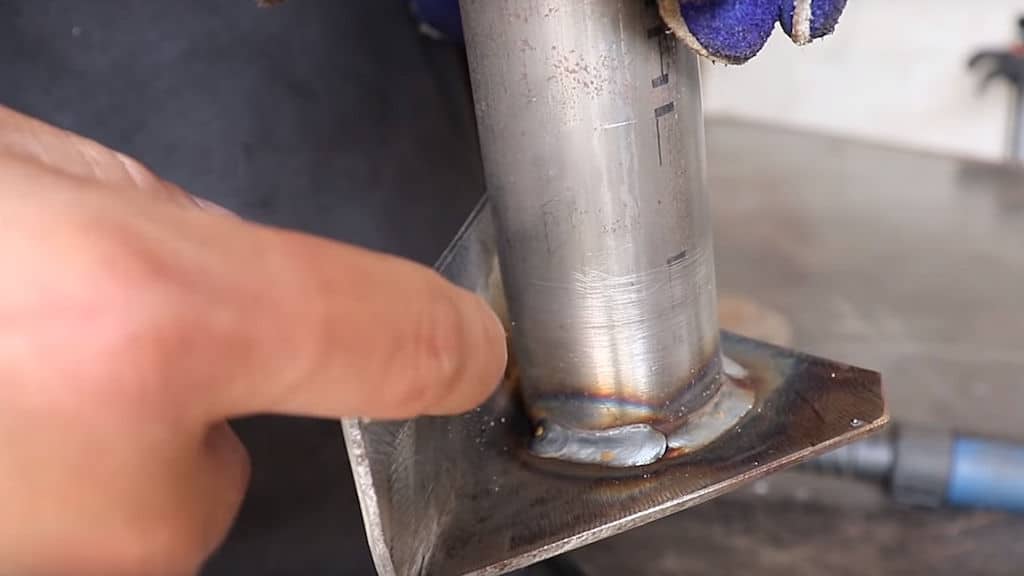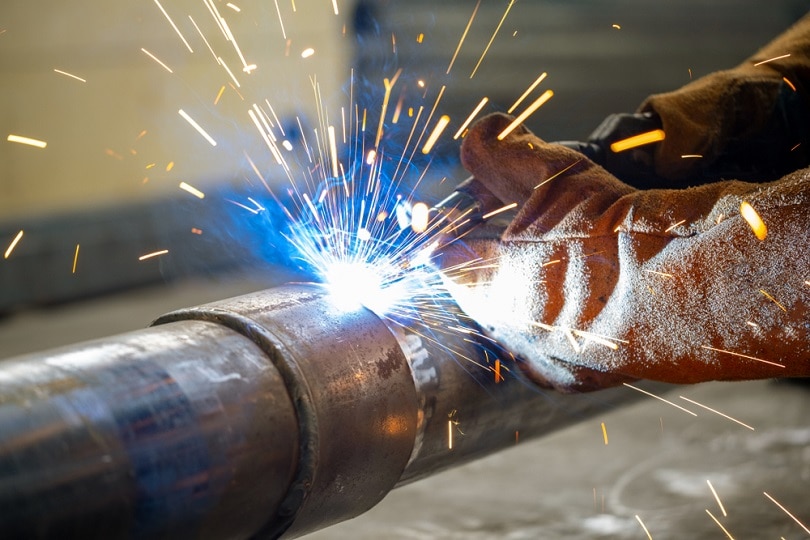How to Mig weld in easy steps. Thinking of a better and neater way to weld your mig without creating that unnecessary mess? That is quite easy! To those who do have full knowledge about what mig welding is all about let me give you a brief description of mig welding.
Mig welding is an amazing method of using electricity to join wires or melting them together. Mig welding is called by different names but performs the same task.
Some welders call them gasless MIG welding, wire feed welder, wire in gas, among others.
We can presume that the welding task is mainly for electricians, welders, and electrical engineers. Whether as a beginner or a professional in the field trust me this article would give answers to some of your questions.
Why do I Use the Mig Welding Technique?
Mig welding is also known as metal inert gas welding. It can be used for almost every form of welding in the welding industry in recent times.
Ranging from heavy to light-sized enterprises such as ship construction, pipelines, makers of steel appliances, pressurized vessels, etc, and the repair and sustenance companies that use the Mig welding.
Furthermore, mig is also used in factories that use sheet metal such as the vehicle producing industry, body shops, and small industries. Users at home and hobbyists also use the MIG welding machine as it gives their project elegant results.
In summary, Mig weld can be used as personal equipment for your garage at home or for professional purposes to perform your client’s projects.
Differences between Mig and Tig welding
Some welders find it hard to distinguish between the MIG and TIG welding types of welding because they are very similar in functions.
This similarity is its use of electricity to generate heat that is utilized to join or melt your project. Though both are great welding processes they can still be differentiated based on their benefits.
While the Mig welding works faster on large and heavy jobs and is quite easy to learn and understand which explains why beginners grasp this process more than the TIG technique.
Also, the Mig welding processes help to weld your project cleaner this can not be said about the Tig welding.
.
What are the Types of Mig welding Transfer I can Adopt for My Welding?
There are several ways in which hobbyists transfer MIG welding from the electricity to the project being worked upon. These methods include; Short Circuit transfer, Spray Transfer, Globular transfer, and Pulsed Spray Transfer. Each of these transfers will be explained briefly in this article.
Short Circuit Transfer: When working on the short circuit transfer you allow the welding wire to get in contact with the metal. Power is generated through the gun and creates a short circuit.
This process allows the welding wire to melt and drop on the metallic face thereby causing a puddle which results in the creation of joints between the pieces being worked upon.
The perfect gas for this type of transfer is the carbon dioxide shielding gas with the right combination of low voltage. A little percentage of shielding gas is needed which makes this type of transfer type less expensive.
Globular Transfer: This transfer occurs when there is a mixture of high power and argon shielding gas which allows the wire to dissolve.
This transfer gets collected at the end of the gun and drops onto the point of the joint only a few times in a second. However, the con of this process is its high level of spatter being produced during operation.
Spray Transfer: Another form of Mig transfer is the spray transfer in which the wire melts down into very neat droplets and then gets sprayed on the work joints like drizzle.
The spray produces a hissing sound like a snake unlike the sound produced by the globular transfer and short circuit transfer types which are popping and cracking sounds respectively.
This transfer type is excellent in producing a clean arc between the gun and the material being worked upon.
This transfer is also produced from the combination of argon shielding gas or gas combination that has a 15% of carbon dioxide and high power or voltage. This shielding gas is nevertheless a bit costly as it uses a high percentage of argon content.
Pulsed Spray Transfer: Do you need an average or low voltage supply to weld your product? This should be your best pick. This transfer process uses a high-end, Mig welder.
The welder in this process thumps the voltage instead of offering a steady flow of power. The outcome is a transfer type that changes between the globular transfer process and the spray process.
It doesn’t require a high voltage to be generated for the process. This gives and includes higher flexibility with stances. However, the Mig welder is not budget-friendly to offer such action and function.
These are the most common types of Mig welding transfer.
Disadvantages of Mig Welding
No welding technique can be termed perfect whether the Mig or Tig welding for all your welding projects. For instance in agriculture or construction tasks where welding is required on-site or in an open field where there is a high percentage of wind, the Mig might not be effective.
Though you can easily use a windshield to protect your weld from the wind. Nevertheless, Mig welding is better when used in an enclosed, controlled, or welding store.
To set up the Mig welding is quite expensive as it requires different components to function well and might be quite expensive.
More so, MIG welding is not easy to maintain. It requires effort to be able to maintain this technique, to get better results.
.
MIG Welding Machine Parts
The Mig welding machine consists of various parts that generate power to supply electricity which eventually produces heat that is used for our task.
Next, it has a wire feed that feeds the cable starting from the weld joint till it gets to the spool.
The handle comes with an activator that controls the level of wire feeder that is fed to the cable on the weld joint and its spool.
More so, shielding gas-guards helps to protect the welder’s work from so much air that might cause disturbance during operation.
Safety Tips on MIG Welding
Do not just be a Mig welder but a better and safe welder. The following tips are sure to help protect you during your mig welding process.
Know the Metal you are working on: Before you start your welding process you must know how every metal you will work on will respond to the welding technique.
Ensure the surface you are welding is clean, if not clean it properly.

Avoid welding galvanized steel: Galvanize steel is made of zinc coating. It helps to produce carcinogenic and dangerous gas that is a bit dangerous when it is burnt.
When you allow the steel to be highly exposed it can cause a high level of metal poisoning also called welding shivers flu which can continue for more than a day and can eventually result in lasting damage.
Be careful of fire: Wilted metal can scatter several meters from a weld. A mashing spark is a worse spark. As any form of plastic bag or sawdust paper in the environment can attract fire easily.
Be careful to ensure your environment is clean before welding. As when you start the operation you might not be aware of the happenings around you as your focus is on your work and might be late before you discover something burning.
To prevent this ensure your work environment is clean and gets your fire extinguisher close to your workshop. Co2 is the nicest type of extinguisher for your welding process.
Water extinguishers are not so great in your workplace because you are working with a lot of electricity.
Employ Your Hands Safely: To manipulate your weld and get a neater finish then carefully work with your hands getting the best spark and ensure to purchase heat-protected welding hand gloves and you will be safe.
Replace the contact tips of your mig welding: Contact tips are budget-friendly but easy to replace. Once you notice that one of your contact tips is a bit faulty, quickly replace them before it causes an unexpected disaster to your welding job.
Take along extra contact tips in your sack of welding equipment.
How to Mig Weld
It is quite easy to migrate, let’s find out.
Hold the welding gun comfortably and conveniently in a position that is quite easy for you to operate.
Ensure the surface you plan to work on is clean as a dirty surface causes bad mig. Remove paints, oil, that might prevent you from achieving your result.
Use a durable ground clamp as it helps to improve the quality of your weld. The full copper ground is the best conductor of electricity. Plated steel with copper jaws might not be a good conductor of heat, thereby causing noise and damaging the welding machine.
Set your MIG welder in the right position. You can achieve this by using the chart of the welding machine and ensure the wire speed is thick enough for the welded metal likewise its voltage. Though your machine might give you a rough lead.
You need to understand your bead. Ropy bead might show that the setting of your weld is not perfect. In this case, you need more heat to get into the metal you are working on.
Components of MIG Welding
The Mig welding includes the following components that you get your desired welding output.
Power source: MIG welding uses a direct current and a stable voltage for operation.
Cable: the wire feed system is expected to operate neatly to enable your welding to come out in a uniform style. The big feeding systems push-pull, pinch rolls, and spool-on-gun.
Anode: Ensure to purchase the right diameter and consider the features of your project to get the right output.
Gas protection: The has which helps to secure your arc and weld pool consists of carbon dioxide and argon.
Filler metal: This functions as a strength to your welding and easily conducts the electric supply which is needed to melt your anode.
Welding touch: this helps to supply the necessary gases to secure the weld pool and arc and then takes the welding current to the cord. Shielding touches can either be air-cooled or water-cooled.
However, air-cooled touches are budget-friendly and light-feel when compared to water-cooled welding touches. Air-cooled uses the gas passing through them to produce a nozzle cool.
Welding torches are perfect for lighter welding tasks. If a hobbyist is making use of high current and working on heavy projects, then your best option is the water-cooled guns.
Conduit: carefully check the position of the conduit and ensure it is straight and not too long to ensure your weld is fed without stress.
.
Conclusion
I am sure we are more informed about Mig welding. Got anyone you know who would find this information useful as you did? Then shoot them this article. Don’t forget to share your opinion on what you think of mig welding.





